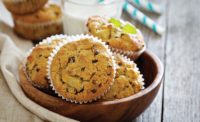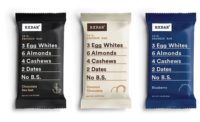
By Dan Malovany
With any team effort, the battle is always won on the lines. That’s the case in football, in hockey and in business, as well. In sales, they call it blocking and tackling. That’s how the real work gets done.
James Skinner Baking Co. adopts a similar philosophy when it comes to production. The producer of thaw-and-serve Danish, coffeecakes, muffins and cinnamon rolls starts the day hitting production hard, and the approach that follows involves grinding it out every day until the job is done correctly.
When a company is producing 200 million products a year, there’s no room for errors and no time for shortcuts. No ifs, ands or buts.
Rather, says Audie Keaton, vice president of the company, the focus is on the fundamentals. That shouldn’t be surprising. Why wouldn’t a Midwestern work ethic fit perfectly for a family-run bakery that’s based in Omaha, Neb.? At Skinner Baking, the philosophy is to leave the fancy footwork to the dancers at a variety show.
As Mike Knott, vice president of finance, who has worked for the Skinner family for 25 years notes, some things never change.
“Through those years, I have witnessed and participated in the culmination of a commitment to producing quality products and simply doing things the right way,” he says.
Take its food safety and defense initiatives, for instance. In addition to regularly being rated superior by American Institute of Baking audits, the 144,000-sq.-ft. plant is routinely inspected throughout the year by its private label and contract manufacturing customers who include some of the biggest of the big in the retail and food industries.
“Food safety has always been paramount at Skinner, and that is reflected with our number of food safety initiatives,” says Dennis Nolan, director of operations. “Right behind food safety is our focus on quality of the product. From our ingredients to our baking methods, we strive to provide the consumer with the best product they can buy.”
To ensure quality, for instance, the company not only has Mirela Vilcan Krueger serving as quality control manager and coordinator of the plant’s Hazard Analysis & Critical Control Point (HACCP) program, but it also has Jennifer Fitzgerald in charge of training employees on food safety as the facility’s quality assurance manager.
Moreover, the plant is working to secure Safe Quality Food (SQF) certification next year under the global food safety initiative. That investment, Keaton says, is top priority with the company.
“A lot of companies aren’t going to put a lot of money into an SQF program, but that’s going to separate us from others,” Keaton explains. “It’s going to ensure that when you eat a Skinner product, you know that you’re getting a product that is safe. We make food. Therefore, we have an iron- clad obligation with our customers to guarantee the integrity of our products.”
The bakery’s food safety and defense program also includes tamper-evident packaging, he adds. Over the years, Skinner Baking has worked with one of its suppliers to improve the integrity of its clamshell packaging. Besides being recyclable, the fourth generation design contains a seal strip that indicates to consumers whether the package has been opened since it left the bakery. The new seal also extended the product’s shelf life to 10 days.
“Skinner Baking started with a 360-degree seal, then added a pull strip with a welded seal and will soon introduce a sleeve around the product so the consumer in the in-store bakery can feel very comfortable that they’re getting a product that hasn’t been tampered with,” Keaton notes.
Home-style Values
If that approach seems a bit old-fashioned, that’s fine with people like Jim Skinner, president of the baking company that he co-founded with his father in 1983. From his perspective, that’s the way a business turns itself into a world-class operation.
For instance, during the early 1900s when his grandfather’s business was known for making macaroni, baked goods, raisin bran cereal and other prepared foods, he recalls how his father traveled every year to North Dakota to check the wheat fields to make sure he was buying the best flour at that time.
“There’s even a strain of wheat named after him,” Skinner says.
Although his father’s first business has long been sold, the lessons from those visits have not been forgotten.
“What we learned from back then was to use real ingredients in all of the products that we make,” Skinner adds. “That’s our background. That’s what we still do today.”
Today, the company makes all of its sweet goods from scratch with ingredients that are found in any family’s pantry. Sometimes it’s the little touches that make a difference.
DuringSnack Food & Wholesale Bakery’svisit, an employee hand sprinkled whole blueberries to the tops of muffins prior to entering the oven so that the fruit could be seen bursting out of the top after the product was baked.
Likewise, Skinner Baking’s Danish are made by laminating the dough up to 108 layers. After makeup, the dough sheets are folded, racked and put overnight in a retarder set at 32˚F to let nature do its work and provide the authentic flavor to the final product.
“This is where the magic happens,” Nolan says. “If you take a deep breath, you can smell the yeast and all that’s happening in this room like the acids developing naturally and the yeast fermenting and the flavor of the dough as it develops its complexity. The fermentation is sweet and mild. There are no chemicals added. It’s just a wholesome natural process. That’s what makes it special.”
Production runs on four, eight-hour shifts six days a week, as well as one, eight-hour shift on Sundays. Bulk flour is stored in two, 105,000-lb. silos. The bakery has a 45,000-lb. tank for soy oil and a 65,000-lb. tank for high-fructose corn syrup. Minor ingredients such as eggs, soy and milk that contain allergens are stored separately under the plant’s HACCP plan, Krueger says. All nuts are kept in a separate room. Prior to production, butter, margarine and other ingredients from the cooler are tempered in another room at ambient temperature prior to be folded into the dough during production.
Overall, the plant houses three production lines that produce muffins on one line, sweet dough products such as cinnamon buns on another and strip dough products such as Danish and coffeecakes on the third line.
The bakery has seven horizontal mixers ranging from 1,300 lb. and 1,600 lb. to 2,000, 2,300 and 3,000 lb. Typically, the smaller mixers are used to make fillings or sponges while the larger mixers handle the 3,000-lb. batches of dough for the yeast-raised products.
Laminated dough is made up in a separate temperature-controlled room from the rest of the process. After mixing, the dough is placed on the laminating line and enters a station that creates three initial layers of butter or margarine and dough that is subsequently folded repeatedly before it passes through a sheeting station that reduces the dough sheet. That process is repeated at a second folding station and through a second sheeter to create up to a 108-layer sheet that’s fermented overnight. Line operators monitor the fat-to-dough ratio repeatedly throughout the day while QA personnel randomly check the tracking process. The laminating has a depositing station to add cinnamon or other fillings for flavoring the dough.
In the main production area on the muffin line, two denesters drop paper cups into 48-piece pans. The cups are filled by two piston depositors. Here, QA personnel take samples to weigh the batter throughout the day to ensure accuracy as a part of the plant’s HACCP program, Fitzgerald says. Each servo-driven piston can be automatically adjusted to ensure that the depositing weight remains accurate throughout the process.
After depositing, the pans enter a thermo-oil, serpentine oven for an even 15- to 20-minute bake. Unlike other types of ovens, the baking temperature is controlled by the heat of the oil, which can be adjusted from the holding tank. After the oil flows from the oven, it’s used to heat the line’s automatic pan washer before it’s recycled and heated for future baking.
After baking and a short cooling, robotics invert and depan the muffins, which travel to a spiral cooler for additional cooling prior to packaging, casepacking and palletizing before being stored in the bakery’s 740-pallet freezer.
Line 2 creates sweet dough products, mini-Danish and cinnamon buns. Here, the dough passes through two triple sheeters that reduce the sheet and control the weight of the products. The sheet passes through a roll cutter that slices it into four strips that are moistened with a spray of water to adhere the dough after filling streusel, cinnamon or other fillings. Four torpedoes, or cone rollers, then roll up the dough, which is cut by a guillotine into individual pieces that are hand panned on parchment paper, racked and rolled into a walk-in proof box. The individual pieces also may receive a variety of toppings to create Danish, pinwheels or other products.
During baking, the products travel through a 90-ft. oven, then loop back for a 180-ft. bake. Products then may receive glazing or a waterfall of icing before traveling through an ammonia-fueled blast freezer. In some cases, the products are packed and trayed before being shrinkwrapped and receiving metal detection. The product is then manually casepacked and palletized before heading to the storage freezer.
Line 3 produces the newJ. Skinnerbranded items and breakfast products such as Danish and coffeecakes. For strip coffeecake on Line 3, the sheeting dough is filled with cinnamon, twisted, rotated and then three strips are placed in a bakeable tray. After proofing and baking in a 156-ft. tunnel oven, the products receive glazing or icing and travel through a spiral 1,700-ft. spiral blast freezer. The trays on Line 3 then enter the packaging area, where they are merged into clamshells that receive the tamper-evident seal. A sonic system welds the top and the bottom of the clamshell to make sure it is tamper-resistant. After receiving a label or sleeve, the products are ink coded with production, lot and shelf life information, then travel through metal detection and palletizing.
Currently, the focus is on ramping up branded production. Down the line, the bakery is looking to add more portion control and value-added products that may contain whole grains or other ingredients to enhance the products’ nutritional profile.
In the end, Keaton says, the company is committed to focusing on the fundamentals and remaining true to producing quality products from the Skinner family recipes.


